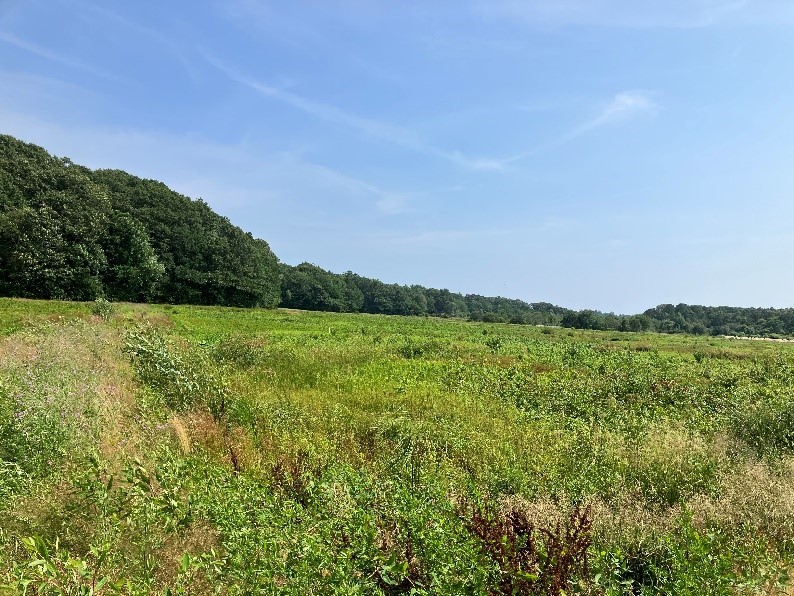SNEP – THE RAIN GARDEN

Bourne, MA: (left to right) Bob Dwyer, Paula Certa, and Keith Barber of the Pocasset Water Quality Coalition point to the site of a rain garden they will develop with SWIG funding along the shore of Hen Cove in Bourne. Photo: Restore America’s Estuaries
Have a photo you want to submit? Submit your photos with a short caption and photo credit with permission of the photo owner to Reilly.Adam@epa.gov with the subject “SNEP Photo Submission.” Photos will be posted to the SNEP Photo Gallery on our website. Our favorite photo of the month will be featured in our next newsletter, so keep those submissions coming! Click to view the complete SNEP Media Gallery
EPA-SNEP Welcomes Two New Staffers. SNEP is thrilled to welcome Natalie Schafer and Christina Madonia to the SNEP Team! Natalie joined the SNEP team this Fall as our Program’s Water Quality Coordinator. She previously worked as a contractor at the EPA Office of Research and Development lab in Narragansett, RI. Natalie earned her Bachelor of Science in Environmental Science with a focus in Data Analytics.
Christina Madonia joins as our Environmental Justice Coordinator and will primarily manage the SNEP Opportunity to Advance Resilience (SOAR) Fund. Christina joins EPA after working for the Department of Ecology in Washington state. She holds a Bachelor of Science in Conservation Biology and Ecology, and a Master’s in Marine and Environmental Affairs. We hope that you will join us in welcoming Natalie and Christina to our team!

On November 9, the SNEP Ecosystem Services subcommittee held its first quarter meeting of fiscal year 2024 to discuss new research priorities for the subcommittee this year, and to review ongoing work. This year, the subcommittee is finalizing a contract to begin improvements to the SNEP Integrated Ecosystem Services Framework (IESF), which will be expanded to better examine some of the climate mitigation benefits of salt marsh systems in the SNEP region. Further, the subcommittee is focusing on a plan to increase the availability of beach count data (number of beach visitors over a given time) in the region. The increased availability of this data will help researchers understand how various beaches are used and valued by their communities. If you have additional information or would like to partner with our subcommittee on improving the availability of beach count data, please contact Reilly.Adam@epa.gov.
On December 1, the SNEP Steering Committee met in-person at the New Bedford Public Library for its first meeting of the fiscal year. The Steering Committee is made up of key partners throughout the region with a mandate to advise on the direction of the Program. During this meeting, the Steering Committee discussed: the state of the region report slated for release in 2025, the FY24 budget, plans for the upcoming SNEP Symposium, review of the SNEP Forum and salt marsh workshop, and the planned renewal of the SNEP Network. Meeting notes will be made available on the SNEP website.
SOAR Fund Selections in Progress. SNEP anticipates making a public announcement of final award recipients in January or February of 2024.
Marstons Mills Cranberry Bog Restoration: A SNEP Pilot Watershed Initiative Project.
In 2021, EPA-SNEP awarded $750,000 over five years to the Barnstable Clean Water Coalition (BCWC) to plan, permit, and implement an ecological restoration of freshwater wetlands on bogs historically farmed for cranberry. The main goal of this multi-faceted restoration project focuses on reducing the nitrogen load being transported down the Marstons Mills River to the Three Bays estuary. Additional benefits of active cranberry bog restoration to freshwater wetlands include increased biodiversity, recreational access, carbon sequestration, and climate resiliency.
A previously farmed cranberry bog in Marston Mills, MA slated for hydrologic restoration to freshwater wetlands. Photo Credit: EPA-SNEP.
To date, BCWC has partnered with several federal, state, nonprofit, and contracting entities to achieve its goal of storing up to 100 acres of wetland habitat in Marstons Mills. Inter-Fluve was competitively selected to complete design and permitting for the project, which hit the 75% design mark this year. Additionally, Marston Mills has been selected as a Priority Project by the Massachusetts Division of Environmental Restoration. In terms of leveraged funding, The Nature Conservancy provided $50,000 in non-federal match, and this year BCWC was awarded $1.27M from the Massachusetts Executive Office of Energy and Environmental Affairs to acquire land slated for restoration. BCWC has also engaged with EPA-Office of Research and Development, the U.S. Geological Survey, the Town of Barnstable, Horsley Witten Group, the Mashpee Wampanoag Tribe, and Woodwell Climate Research Center.

While several cranberry bog restoration projects (including past and ongoing SNEP-funded projects at Childs River in Falmouth, MA and Windswept Bogs in Nantucket, MA) have been planned and completed in Massachusetts in the past decade, this is one of the first with a specific focus on nitrogen load reductions. BCWC is monitoring and will compare water quality parameters and ecosystem condition pre-restoration and post-restoration to understand the nutrient impacts of wetland restoration in former cranberry bogs. BCWC convenes meetings for partners interested in all the potential benefits of habitat restoration, and they will meet in early December as the project phases into the permitting process over the next year.
